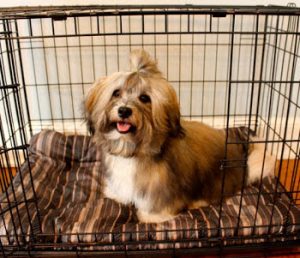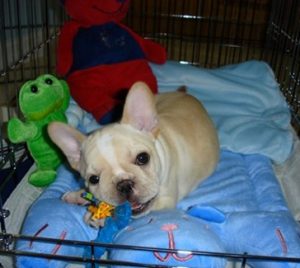So, you’ve got a new puppy and along with it came all the new responsibilities of training and caring for it. Beginning from day one you and your dog are both learning about feeding, playing, and bathroom habits. However, one crucial skill you should also consider mastering with your pet is crate training.
Reasons to have your pet crate trained:
Having your dog crate trained can benefit not only the dog owners but also the dogs themselves. Many owners have busy schedules that require them to either transport their dog to and from places or leave them alone for a few hours. Having your dog in a crate during car rides or at home while you’re away can ensure that they are safe and not getting into anything they shouldn’t be. Some dogs find crates useful for reducing anxiety. It gives them a small place where they can rest and feel safe. Whatever the case may be, crate training can be a helpful skill to teach your pet.
A common myth about crate training is that it is cruel for your animal. However, this is far from the truth. Your dogs’ ancestors sought out small dens to rest in and feel safe thousands of years ago, in the wild. A crate can help facilitate that instinctual need to have a cozy area for your pet to feel protected in. For puppies and smaller dogs, this need for a small space to rest in can be even more necessary because of the overwhelming size of a home.
Although they are cute, having a puppy tends to come with the risk of them destroying your house when nobody is watching. Crating them while you’re busy gives you the confidence of knowing that your home and pet will remain just as you left them.
If you have decided that crate training your dog is the right thing for you, there are some guidelines you should follow to be successful.
Do: Find a crate that accommodates your dog according to their size
This rule can be a little tricky when you have a puppy because you want to get them a crate that they will be comfortable in as they grow. Certain dogs like bull mastiff puppies start small and weigh around 30 pounds as puppies however, they grow to weigh up to almost 200 pounds depending on their gender. Although most dogs don’t grow that large, it’s important to account for the size that your dogs breed may grow to.
If you know your dog is going to get bigger but do not want to buy too large or too small of a crate utilize crate dividers that can be found at most places where crates are sold. The dividers allow you to give your pet enough space to feel comfortable in a big crate but not enough space to roam too much or have an accident. Once they grow you can move the dividers accordingly or get rid of them all together and utilize the entire space that a bigger crate has to offer.
Don’t: Use the crate as a punishment
When crate training your dog you want to make sure they feel as comfortable as possible while being inside the crate. Associate the crate with fun by giving them a treat or a toy when they are inside of it. Place a bed or a warm blanket on the floor of the crate so your pup can lay down and rest while they spend their time inside their “room.”
Some dogs may get anxious and need rest from the chaos of family get togethers or even thunder storms. This is when you can place your dog into the crate to make them feel safe. Laying a thin blanket on top of the crate can assist with help making the crate feel more soothing and allow the pup to sleep easier. Just make sure there is still a passage for air to come in and out so you don’t suffocate your poor pup.
Do: Feed them meals and have water available in the crate
Training your dog to eat in the crate can help substantially when it comes to getting them comfortable with the space. Allow some time for your pet to sniff around the crate and get familiar with their surroundings before putting the food bowl into the crate. Encouraging them to step in and eat while closing the door behind them quietly will take some stress away from the situation. Once they have finished eating let them out and let them know that you are happy with them. The more you practice feeding your dog in the crate the safer they will feel when the times comes to go in.
Don’t: Leave your dog in a crate for more than 3 or 4 hours
The crate isn’t meant to imprison your pet. It should be used only when needed otherwise your dog will grow to dislike the crate and may refuse to get in. Puppies especially should not be forced to stay in a crate for long periods of time because of their smaller bladders. Older dogs can physically hold it for up to around 7 hours but should not be forced to unless necessary. Keeping your puppy in a confined space for too long could result in them soiling their bed causing discomfort and a mess for you to clean up. Avoid this by simply taking your pup out of the crate frequently for bathroom breaks. If you are unable to supervise your puppy while they are in the crate you may need to change your schedule around or ask for help.

Every dog is different. Its important to find a crate that is the most suited for your dogs breed and size.
Do: Be patient
Every dog is different. It could take more or less time to successfully crate train your dog depending on their personality and anxiety level. Your dog needs a lot of encouragement and support while learning to go in and out of the crate comfortably. You may have to repeat yourself often and continue to provide treats or toys until your dog can be confident that the crate is a good place. Once they have gotten in and out of the crate a few times try closing the door and opening it to get them used to the feeling of being confined in the space. Always reassuring them with a happy tone of voice can make the transition easier and faster to get the hang of.
Don’t: Be too demanding
Your dog wants to be your best friend (usually). However, they aren’t always sure of what you want them to do. Going in and out of the crate can be confusing or cause a lot of stress for dogs that are first trying it. Be aware of this and make sure that you aren’t too demanding of your dog right off the bat. Stay enthusiastic when attempting to persuade your dog to get into the crate and don’t have such high expectations on the first day. Crate training could take weeks depending on the dog, so make sure to not be too hard on your pup if they can’t get it the first couple of tries.

Being in a crate should not be associated with punishment or stress. It should be used to give your pup a break and allow them some time to relax.
Do your research:
Don’t be afraid to search for little tips and tricks on how to work with your dog during the crate training process. Research crates and find one that’s best for you and your pet considering size, visibility, and comfort. Doing my own research I found many helpful articles from sites like the American Kennel Club, The Humane Society of the United States, and Caesars Way. Below I’ve posted some links that will help you navigate through your journey of crate training your dog.
Puppy crate training made easy
Lazarus Gomez, Managing Editor, is an aspiring writer from Phoenix, Arizona and has been freelance writing for local newspapers. He is currently majoring in journalism at New Mexico State University. He has always been an avid animal lover and has two large bulldogs named Levi and Diesel as well as a German Shepard named Zeus. He currently resides in Las Cruces, New Mexico and is hoping to pursue his passion in sports writing. You can e-mail Laz at lgomez@yourpetspace.info




